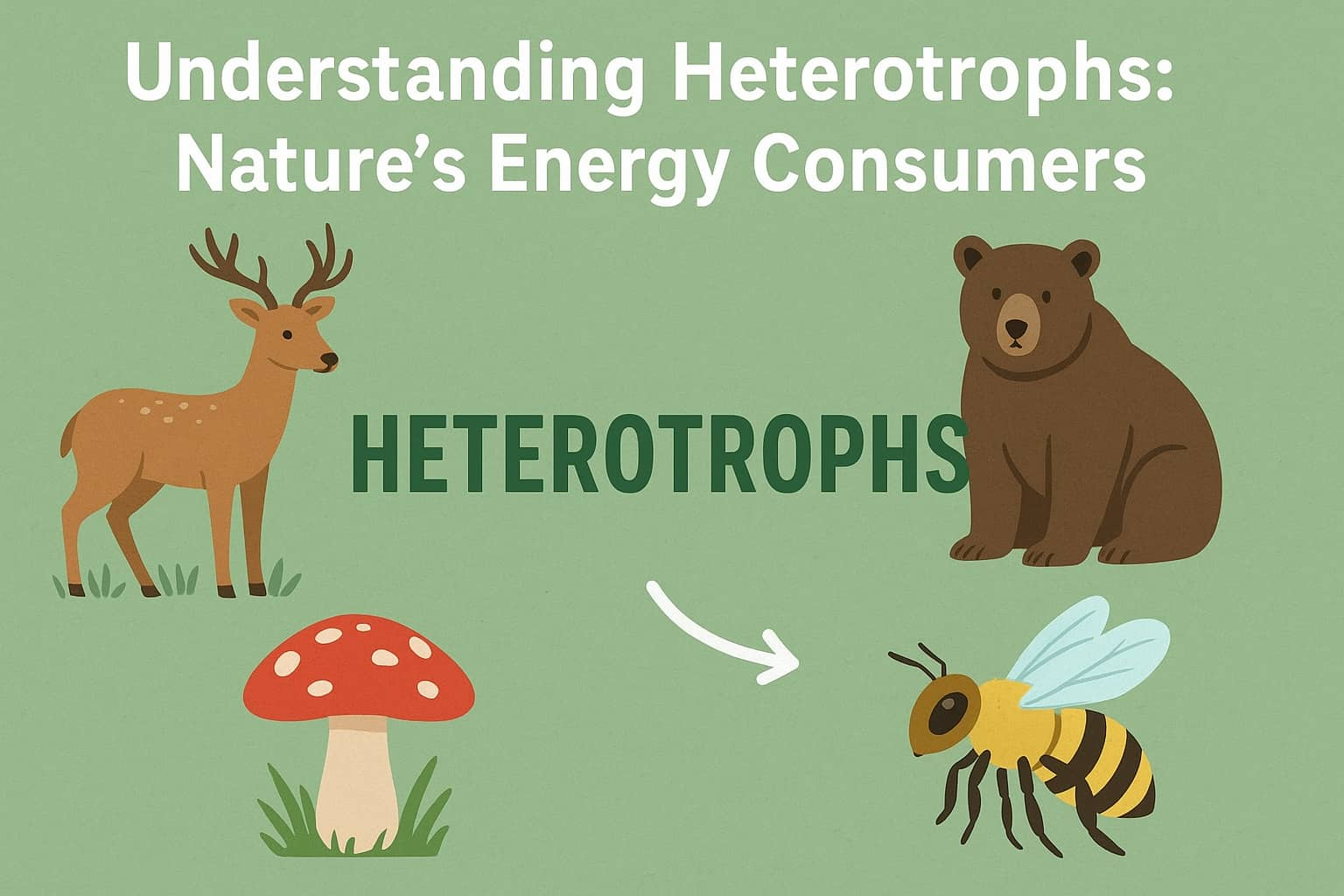Understanding Heterotrophs: Nature's Energy Consumers
 November 3, 2025
November 3, 2025
Heterotrophs are organisms that cannot produce their own food. Instead, they must rely on consuming other organisms—plants, animals, fungi, or even bacteria—to obtain the energy and nutrients they need to survive. The term "heterotroph" comes from the Greek words "hetero," meaning different, and "troph," meaning nourishment. Unlike autotrophs, which can synthesize their own nutrients, heterotrophs are dependent on the organic substances produced by other living things. This makes them integral components of food webs, as they connect the energy flow from producers to higher trophic levels.
The Origin of the Term
The concept of heterotrophy has evolved significantly since its inception. The term was coined in the early 20th century as scientists began to understand the complex interactions within ecosystems. Early studies focused on the obvious consumers like animals, but over time, the role of bacteria and fungi as heterotrophs gained recognition. Today, the understanding of heterotrophs encompasses a diverse array of organisms that contribute to the nutrient cycles and energy flows critical to life on Earth.
Differentiating Heterotrophs from Autotrophs
To better understand heterotrophs, it is helpful to compare them to autotrophs. Autotrophs are organisms that can produce their own food using light, water, carbon dioxide, or other chemicals. Plants, algae, and some bacteria are examples of autotrophs. They are often referred to as producers because they form the base of the food chain by creating energy that other organisms, like heterotrophs, depend on. In contrast, heterotrophs are consumers because they obtain energy from autotrophs or other heterotrophs. This distinction is crucial for understanding food chains and ecosystems.
The Dependency of Ecosystems on Heterotrophs
Ecosystems are dynamic systems where energy and nutrients are transferred through various trophic levels. Heterotrophs play a critical role in this transfer. Without them, the energy produced by autotrophs would remain unused, and the organic matter would accumulate, leading to ecological imbalance. The symbiotic relationship between autotrophs and heterotrophs ensures the recycling of nutrients, maintaining the health and sustainability of ecosystems.
Types of Heterotrophs
Heterotrophs come in various forms and play different roles within ecosystems. Let's explore some of the primary types.
Herbivores
Herbivores are heterotrophs that primarily consume plants. They are crucial for transferring energy from plants to other animals in the food chain. Examples of herbivores include deer, rabbits, and cows. These animals have specialised digestive systems that enable them to break down tough plant materials, such as cellulose. Herbivores often possess adaptations such as multi-chambered stomachs or elongated intestines to aid in the digestion of fibrous plant tissues.
The Role of Herbivores in Ecosystems
Herbivores contribute significantly to shaping the vegetation structure of their habitats. By grazing, they influence plant community composition, which in turn affects the entire ecosystem. Their feeding habits can stimulate plant growth and maintain the balance between different plant species. Additionally, herbivores serve as prey for carnivores, forming a critical link in the food chain.
Herbivorous Adaptations
Herbivores have evolved various adaptations to efficiently process plant materials. For instance, ruminants like cows have a specialized stomach with multiple compartments, allowing them to ferment plant matter and extract maximum nutrients. Other herbivores, such as rabbits, re-ingest their feces to digest their food more thoroughly, a process known as coprophagy.
Impact of Herbivores on Human Activities
Humans have domesticated several herbivorous species for agricultural purposes. Livestock such as cattle, sheep, and goats provide meat, milk, and wool, playing a significant role in human economies. However, overgrazing by livestock can lead to land degradation and desertification, highlighting the need for sustainable management practices.
Carnivores
Carnivores are heterotrophs that eat other animals. They are often at or near the top of the food chain and play a vital role in controlling the population of other species. Lions, wolves, and eagles are all examples of carnivores. Some carnivores, like cheetahs, have evolved to be fast and agile hunters, while others, like crocodiles, rely on stealth and power.
The Ecological Role of Carnivores
Carnivores help regulate prey populations, preventing overpopulation and the subsequent depletion of vegetation. This top-down control maintains the balance within ecosystems and ensures that no single species dominates. By preying on the weak and sick, carnivores also contribute to the health of prey populations by encouraging natural selection.
Hunting Strategies and Adaptations
Carnivores exhibit a wide range of hunting strategies and adaptations. Ambush predators like tigers rely on camouflage and stealth to approach their prey unnoticed. In contrast, pack hunters such as wolves use coordinated efforts to take down larger animals. These adaptations are crucial for their survival and success as predators.
Human-Carnivore Interactions
Human expansion has led to increased encounters with carnivores, often resulting in conflicts. Conservation efforts aim to protect these apex predators and their habitats while minimizing human-wildlife conflicts. Understanding the ecological importance of carnivores is essential for fostering coexistence and maintaining biodiversity.
Omnivores
Omnivores are versatile heterotrophs that consume both plants and animals. This dietary flexibility allows them to adapt to different environments and availability of food sources. Humans, bears, and pigs are examples of omnivores. This adaptability often gives omnivores an advantage in changing ecosystems.
Advantages of Omnivorous Diets
Omnivores benefit from their ability to exploit a wide range of food sources. This dietary diversity allows them to survive in varied environments and respond to fluctuations in food availability. Omnivores can switch between plant and animal diets depending on seasonal changes, making them resilient to environmental pressures.
Omnivores in Ecosystem Dynamics
By consuming both plant and animal matter, omnivores occupy unique niches within ecosystems. They contribute to both herbivorous and carnivorous trophic levels, influencing the structure and dynamics of food webs. Omnivores can act as seed dispersers and predators, affecting plant populations and controlling herbivore numbers.
Human Influence on Omnivorous Species
Human activities, such as agriculture and urbanization, have impacted omnivorous species. Some, like raccoons and crows, have adapted well to human-altered landscapes, thriving in urban environments. However, others may face challenges due to habitat loss and competition with humans for resources.
Decomposers
Decomposers are a unique group of heterotrophs that break down dead organic matter, recycling nutrients back into the ecosystem. Fungi and bacteria are the primary decomposers. They play a critical role in maintaining soil health and nutrient cycling, ensuring that ecosystems remain balanced and productive.
The Importance of Decomposition
Decomposition is a fundamental process that recycles nutrients, making them available for primary producers. Decomposers break down complex organic materials into simpler compounds, facilitating nutrient uptake by plants. Without decomposers, ecosystems would be overwhelmed with organic waste, and nutrient cycles would be disrupted.
Diversity of Decomposer Organisms
Decomposers encompass a wide variety of organisms, including fungi, bacteria, and detritivores like earthworms. Fungi are particularly effective decomposers, capable of breaking down tough substances like lignin and cellulose. Bacteria also play a significant role in nutrient cycling, especially in aquatic environments where they decompose organic matter.
Human Impact on Decomposer Communities
Human activities, such as pollution and land use changes, can affect decomposer communities. Chemical pollutants may inhibit the activity of decomposers, reducing nutrient availability for plants. Understanding and preserving the diversity of decomposer organisms is essential for maintaining ecosystem health and productivity.
The Role of Heterotrophs in Ecosystems
Heterotrophs are essential for the flow of energy through ecosystems. They help maintain balance by controlling populations of other organisms and recycling nutrients.
Energy Flow
Energy in an ecosystem flows from producers (autotrophs) to consumers (heterotrophs). This flow is often represented as a food chain or food web. Heterotrophs, as consumers, are crucial links in these chains, transferring energy from one level to another. For example, a simple food chain might start with grass (a producer) being eaten by a rabbit (a primary consumer and herbivore), which is then eaten by a fox (a secondary consumer and carnivore). Each step in the food chain represents a transfer of energy.
Food Chains and Food Webs
Food chains are linear representations of energy flow, illustrating the direct transfer of energy from one organism to another. However, ecosystems are more accurately represented by food webs, which demonstrate the complex interconnections between various organisms. Food webs highlight the multiple feeding relationships within ecosystems, showcasing the intricate balance maintained by heterotrophs.
Trophic Levels and Energy Efficiency
Each step in a food chain represents a different trophic level, with energy transferred from one level to the next. However, energy transfer is not entirely efficient, as only a small percentage of energy is passed on to the next level. This inefficiency is due to energy loss through metabolic processes and heat. Understanding energy flow and trophic levels is crucial for analyzing ecosystem dynamics and the role of heterotrophs.
The Keystone Role of Apex Predators
Apex predators, often at the top of the food chain, play a keystone role in ecosystems. They regulate prey populations, prevent overgrazing, and maintain biodiversity. The presence or absence of apex predators can have cascading effects throughout the ecosystem, affecting both lower trophic levels and the overall structure of the food web.
Population Control
Heterotrophs also play a vital role in controlling the populations of other species. Predators help manage the populations of prey species, preventing them from overgrazing and depleting resources. This balance is essential for ecosystem stability.
Predation and Population Dynamics
Predation exerts selective pressure on prey populations, influencing their behavior, reproduction, and survival. Predators often target the sick, weak, or young individuals, promoting healthier prey populations. This natural regulation prevents overpopulation and resource depletion, contributing to ecosystem stability.
Herbivory and Plant Population Control
Herbivores influence plant populations through their feeding activities. By consuming specific plant species, herbivores can shape plant community composition and structure. This selective feeding can promote biodiversity and prevent the dominance of any single plant species, maintaining ecosystem resilience.
The Role of Human Intervention
Human activities, such as hunting and habitat modification, can disrupt natural population control mechanisms. Overhunting of predators or prey can lead to imbalances, affecting entire ecosystems. Conservation efforts aim to restore natural population dynamics and minimize human-induced disruptions.
Nutrient Cycling
Decomposers, a type of heterotroph, are responsible for breaking down dead organic matter. This process releases nutrients back into the soil, making them available for plants to use. Without decomposers, ecosystems would quickly become overwhelmed with waste and run out of essential nutrients.
The Decomposition Process
Decomposition involves the breakdown of organic matter into simpler compounds by decomposers. This process is crucial for nutrient cycling, as it releases essential elements like nitrogen, phosphorus, and carbon back into the environment. These nutrients are then absorbed by plants, continuing the cycle of life.
The Impact of Decomposition on Soil Health
Decomposition contributes to soil fertility and health by enriching the soil with organic matter and nutrients. Healthy soils support plant growth, which in turn supports heterotrophs and the entire ecosystem. The presence and activity of decomposers are indicators of soil health and ecosystem productivity.
Human Influence on Nutrient Cycling
Human activities, such as agriculture and waste management, can affect nutrient cycling. Excessive use of fertilizers and improper waste disposal can lead to nutrient imbalances and pollution. Sustainable practices and understanding the role of decomposers are essential for maintaining nutrient cycles and ecosystem health.
Heterotrophs and Human Impact
Human activities have a significant impact on heterotrophs and the ecosystems they inhabit. Understanding these impacts is crucial for conservation and sustainable resource management.
Habitat Destruction
Habitat destruction is one of the most significant threats to heterotrophs. As forests are cleared for agriculture or urban development, the natural habitats of many heterotrophic species are lost. This can lead to declines in biodiversity and disrupt the balance of ecosystems.
The Consequences of Habitat Loss
Habitat loss results in the fragmentation and degradation of ecosystems, reducing the availability of resources and shelter for heterotrophs. This can lead to population declines, loss of genetic diversity, and increased vulnerability to environmental changes. Protecting and restoring natural habitats is essential for conserving biodiversity and maintaining ecosystem functions.
The Role of Conservation Efforts
Conservation efforts focus on preserving habitats and protecting endangered species. Establishing protected areas, restoring degraded habitats, and implementing sustainable land use practices are vital strategies for mitigating habitat destruction. Public awareness and involvement are also crucial for successful conservation initiatives.
Urbanization and Its Impact on Heterotrophs
Urbanization alters natural landscapes, affecting the distribution and behavior of heterotrophs. Some species adapt to urban environments, while others may face challenges due to habitat loss and pollution. Urban planning that incorporates green spaces and wildlife corridors can help mitigate the impact of urbanization on heterotrophs.
Pollution
Pollution can have severe effects on heterotrophs, particularly those that rely on clean air, water, and soil. Contaminants can accumulate in the food chain, affecting predators at the top levels most severely.
Types of Pollution Affecting Heterotrophs
Pollution can take many forms, including air, water, and soil pollution. Air pollution can affect respiratory health, while water pollution can contaminate food sources and habitats. Soil pollution can disrupt nutrient cycling and affect plant growth, indirectly impacting heterotrophs.
The Phenomenon of Bioaccumulation
Bioaccumulation refers to the accumulation of pollutants in the tissues of organisms. As contaminants move up the food chain, their concentration increases, posing significant risks to top predators. Understanding and addressing bioaccumulation is essential for protecting both heterotrophs and human health.
Strategies for Pollution Mitigation
Efforts to reduce pollution include regulating industrial emissions, promoting sustainable agriculture, and improving waste management practices. Public awareness and education play a crucial role in encouraging responsible behaviors and reducing pollution's impact on heterotrophs.
Climate Change
Climate change is altering ecosystems worldwide, affecting the availability of food and habitats for heterotrophs. Species that cannot adapt quickly enough may face extinction, leading to further imbalances in ecosystems.
The Impact of Climate Change on Heterotrophs
Climate change affects temperature, precipitation, and habitat availability, influencing the distribution and behavior of heterotrophs. Some species may expand their range, while others may face habitat loss and increased competition. Understanding these impacts is crucial for developing strategies to mitigate climate change effects on biodiversity.
Adaptation and Resilience of Heterotrophs
Some heterotrophs exhibit adaptability and resilience to changing climates. Behavioral changes, such as altering migration patterns or diet, can help species cope with environmental shifts. However, rapid climate change may outpace the adaptive capacity of many species, necessitating conservation interventions.
Human Responsibilities in Combating Climate Change
Addressing climate change requires global cooperation and commitment to reducing greenhouse gas emissions and promoting sustainable practices. Protecting natural ecosystems and enhancing habitat connectivity can improve the resilience of heterotrophs to climate change. Public awareness and policy changes are essential for driving meaningful action.
Conclusion
Heterotrophs are a vital component of Earth's ecosystems. They connect the energy created by autotrophs to the wider food web, ensuring the flow of energy and recycling of nutrients. By understanding their roles and the challenges they face, we can better appreciate the diversity of life and the importance of maintaining balanced ecosystems. As we move forward, it is crucial to consider how our actions impact these essential organisms and work towards a sustainable future for all life on Earth. The conservation of heterotrophs and their habitats is not only vital for ecological health but also for the continued well-being of humanity.
Recent Posts
Categories
Tags






